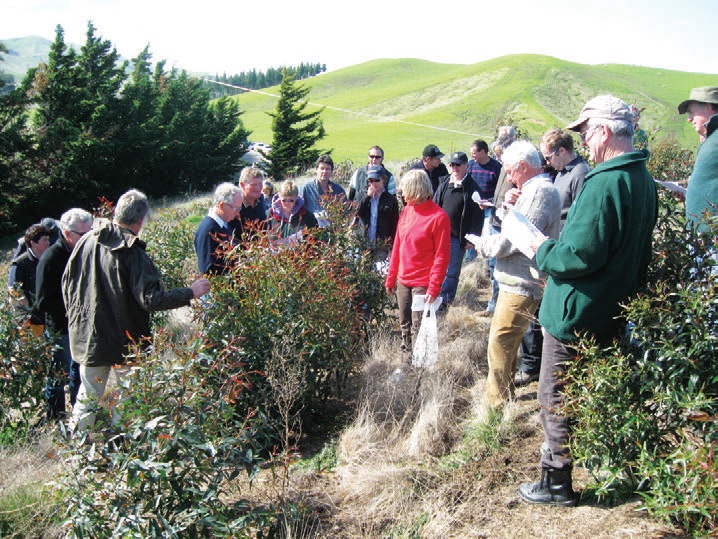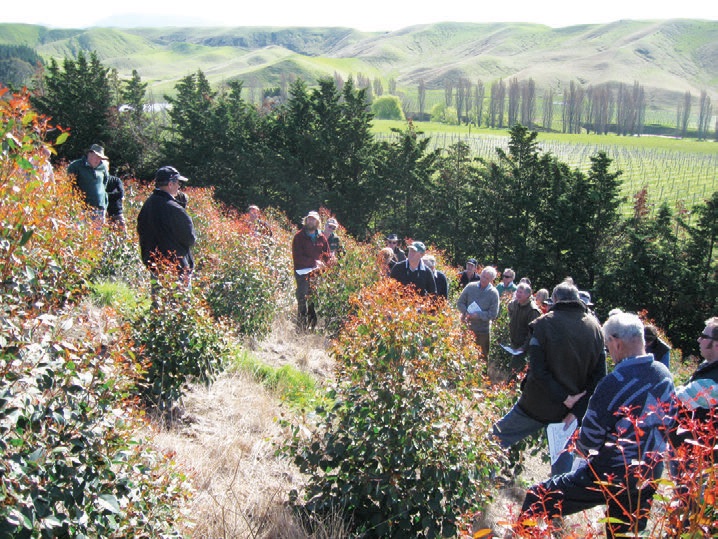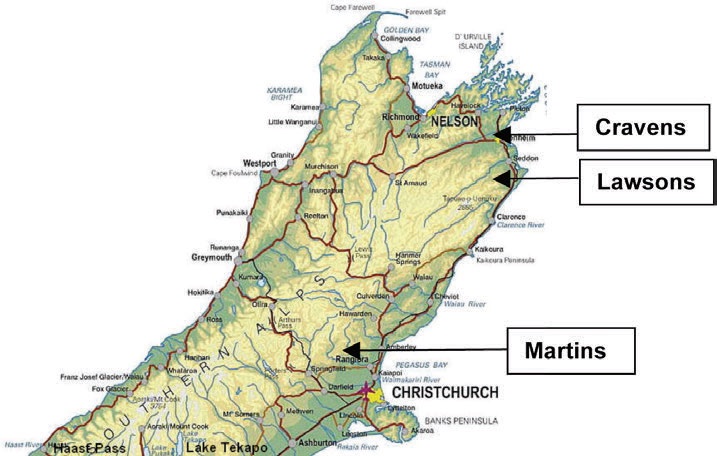Dryland Forest Initiative Field day in Marlborough
Paul Millen, New Zealand Tree Grower February 2011.
In September last year a group of about 40 gathered at Andrew and Ngaire Lawson’s property. They were all keen to look around the Dryland Forests Initiative’s trials planted a year earlier in October 2009. This site is planted with a breeding population of Eucalyptus bosistoana as well as small trials of several other durable species.
The main objective of the initiative is to breed and develop forest management systems to grow eucalypts which produce high value naturally durable hardwoods.
Species selection
The Dryland Forests Initiative (NZDFI) has selected species which −
- Produce highly durable timber
- Are drought tolerant
- Coppice vigorously after fire and harvesting
- Do not spread as wildings
- Sequester carbon faster than pine on drylands
- Provide nectar and pollen for native biodiversity
- Are eligible as species for MAF’s Afforestation Grants Scheme and Emissions Trading Scheme.
Large numbers of trees are needed in the breeding populations to select improved germplasm for commercial release. Diverse sites in several dryland regions will test the species across a range of environments and provide comparative data. Early screening for growth and form to select the best provenances and individuals for superior traits including wood properties, rapid growth and improved form, will begin from 2012. It is expected that the first improved selections will be available for commercial nurseries from 2014.
Durable eucalypt trials at Lawson property planted October 2009
| Breeding species | Durability Class and air dry density kg/m3 | Heart wood colour and texture | Annual rainfall mm | Annual frosts and coldest minimum temperature | Occurrence | NZDFI associated species | Soil fertility requirements |
|---|---|---|---|---|---|---|---|
| E. bosistoana | 1; 1100 | brown/pink; fine even texture. | 700 to 1200 | Up to 40 -5°C | Coastal areas of southern NSW and eastern Victoria. | E. globoidea | High |
| E. argophloia | 1; 1005 | dark red; fi ne to medium texture | 650 to 900 | 10 to 15 -5°C | Inland tablelands southern Queensland | None | Poor to medium |
| E. quadrangulata | 1 to 2; 1020 | pale yellow brown; fi ne uniform texture | 900 to 1700 | up to 50 -8°C | Tablelands of central and northern NSW. | None | Medium to high |
| E. globoidea | 2; 900 | cream & pink; moderately fine texture. | 650 to 1400 | up to 40 -5°C | Coastal areas of southern NSW and eastern Victoria. | E. bosistoana | Poor to medium |
| E. camaldulensis | 2; 880 | red; fi ne texture | 300 to 600 | Up to 20 (- ?) | Inland arid river terraces of Australia | None | Poor to medium |
| Potential breeding species | |||||||
| E. cladocalyx | 1; 1100 | Pale yellow brown heartwood, fi ne uniform texture | 380 to 650 | 0 - 20 -2°C | South Australia | None | Poor to medium |
| E. macrorhyncha | 3; 900 | Reddish brown, moderately fi ne texture | 500 to 1000 | Up to 70 -10°C | Inland NSW and Victoria | None | medium |
| E. sphaerocarpa | 1 to 2; 945 | Brown, coarse grain | 1000 | ? | Southern Queensland | None | Poor to medium |
Trial design
The simplest trial design is to establish family block or row plantings. However the single tree plot incomplete block design was used in preference for several reasons −
- To provide more precise genetic parameter estimates
- To allow for permanent sample plots to be established across the trial for the collection of data to use in growth model development
- To enable the trial to be used to collect open pollinated seed for the next generation of breeding
- To maximise crossing between families and reduce the incidence of inbreeding
- To enable the lower ranked families to be removed and the trial converted into a seed stand
In addition, large numbers of trees allow for extensive within-family selection and for destructive sampling for wood property evaluation without compromising the genetic estimates.


Breeding populations of Eucalyptus bosistoana
Sites were planted at Lawson, Cravens and Martins, and are shown on the map.
Climatic data for trial sites
| Site | Mean annual rainfall mm | Mean annual maximum temperature oC | Mean annual minimum temperature oC | Minimum annual temperature oC |
|---|---|---|---|---|
| Cravens | 668 | 18.3 | 7.6 | 2.3 |
| Lawsons | 590 | 17.1 | 9.3 | 4.2 |
| Martins | 750 | 17.0 | 5.9 | 1.7 |
Seed collection, propagation and planting
A total of 76 open-pollinated seedlots were collected in 2008 from individual trees growing across the natural range of E. bosistoana in Australia. The seed was sown by Morgan Road Nursery, Blenheim in November 2008 to raise containerised seedlings for planting in October 2009.
Each site contains 150 blocks of 25 and 30 single trees. Spacing is 1.8 metres within the row and 2.4 metres between rows and equates to 2,312 stems per hectare.
The location of each family within a block is random. Generally 75 seedlings of each family were allocated across the 150 blocks and the three sites.
Demonstration and leaflets
There will be NZDFI planting regional demonstration trials in each region, and a series of leaflets are being developed which summarise current information for selected durable species and potential management options. These are due to be published on line by December 2011.
Regional workshops and field visits to demonstration trials are planned to start from January 2012 through to May 2013, with a professional research and development seminar in late 2011. Pilot wood quality evaluation are being completed by the School of Forestry to assess wood quality traits at age two using potted plants grown in a greenhouse.


 Farm Forestry New Zealand
Farm Forestry New Zealand

